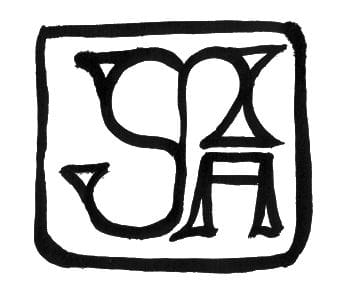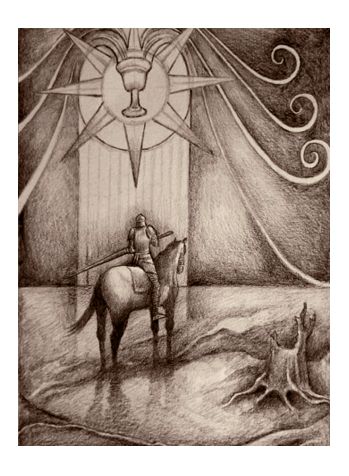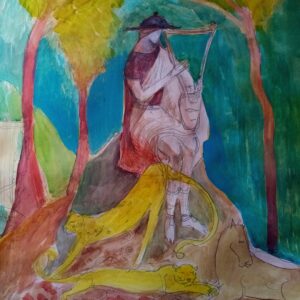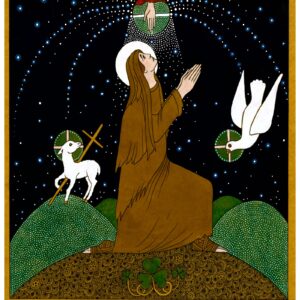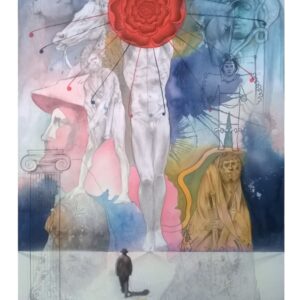Description
The wasteland and the Holy grail
Original drawing.
A4 fabriano paper.
Comes with a custom frame upon purchase.
The wasteland in medieval texts is a recurring theme that serves as a metaphor for the moral and spiritual decay of society. This concept is prominently featured in various literary works from the medieval period, such as Sir Thomas Malory’s “Le Morte d’Arthur” and Geoffrey Chaucer’s “The Canterbury Tales”. In these texts, the wasteland represents a barren, desolate landscape that mirrors the corruption and decadence of the characters within the story.
One of the most famous depictions of the wasteland in medieval literature is found in the quest for the Holy Grail. In Arthurian legends, the Grail is often associated with the rejuvenation and renewal of the wasteland, as the quest for this sacred object symbolizes the search for spiritual fulfillment and redemption. The wasteland serves as a physical manifestation of the moral and ethical decay of society, and the quest for the Holy Grail represents the journey towards spiritual enlightenment and salvation.
In “Le Morte d’Arthur”, the wasteland is portrayed as a harsh and unforgiving environment that reflects the moral shortcomings of the characters in the story. King Arthur’s kingdom falls into disarray and chaos, symbolized by the desolation of the wasteland. The knights of the Round Table embark on quests to restore the land to its former glory, facing trials and tribulations along the way that test their virtue and integrity.
Similarly, in Chaucer’s “The Canterbury Tales”, the wasteland serves as a backdrop for the pilgrims’ tales of sin, redemption, and morality. The characters in the tales come from different walks of life, representing various aspects of medieval society, and their stories reflect the moral dilemmas and ethical quandaries of the time. The wasteland becomes a symbol of the spiritual emptiness and moral decay that permeates society, highlighting the need for moral and ethical renewal.
The wasteland in medieval texts also serves as a symbolic representation of the consequences of human greed, ambition, and hubris. Characters who are driven by a desire for power, wealth, or social status often bring about their own downfall, leading to the desolation of the land and the suffering of the people around them. The wasteland becomes a cautionary tale about the dangers of unchecked ambition and the repercussions of moral corruption.
Furthermore, the wasteland in medieval texts is often associated with themes of death, decay, and rebirth. The barren landscape mirrors the cycle of life and death, illustrating the impermanence of worldly possessions and the inevitability of mortality. Characters who confront the wasteland are forced to confront their own mortality and the limitations of human existence, leading to moments of introspection and self-discovery.
The wasteland in medieval literature can also be interpreted as a metaphor for the struggle between good and evil, light and darkness. Characters who confront the wasteland are faced with moral choices that test their virtue and integrity, forcing them to confront their own inner demons and weaknesses. The wasteland becomes a battleground for the forces of good and evil, with characters struggling to overcome obstacles and challenges in order to achieve redemption and salvation.
- In conclusion, the wasteland in medieval texts is a powerful and evocative symbol that encapsulates the moral and spiritual dilemmas of the characters within the story. It serves as a metaphor for the decay and corruption of society, as well as a reflection of the characters’ inner conflicts and struggles. The quest for renewal, redemption, and salvation is often linked to the wasteland, as characters confront their own shortcomings and strive to overcome the moral challenges before them. The wasteland in medieval literature continues to resonate with readers today, highlighting universal themes of moral ambiguity, spiritual renewal, and the eternal struggle between good and evil.
